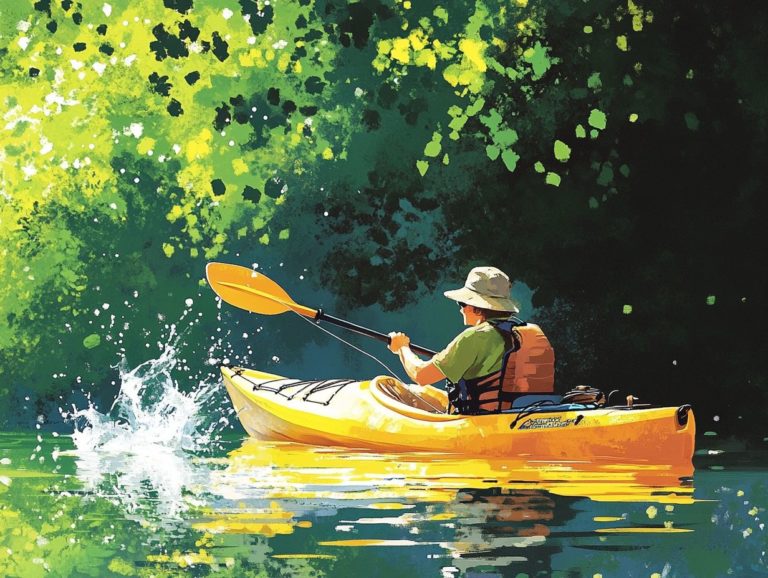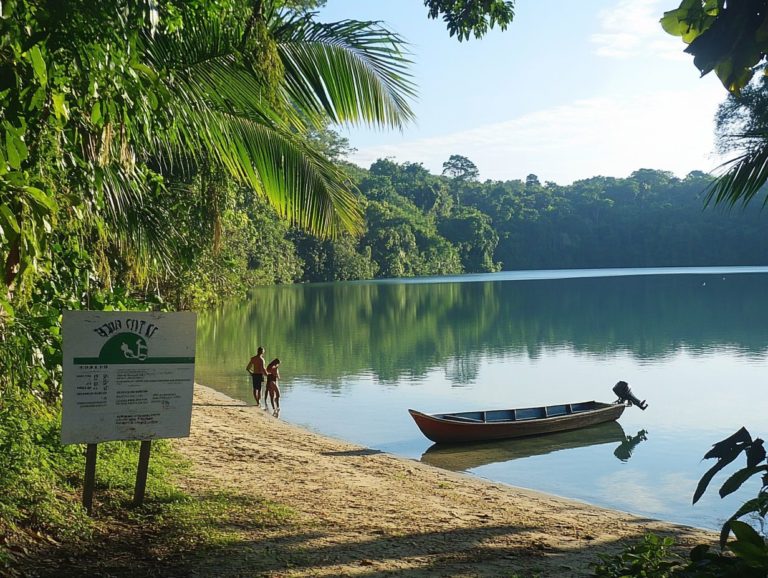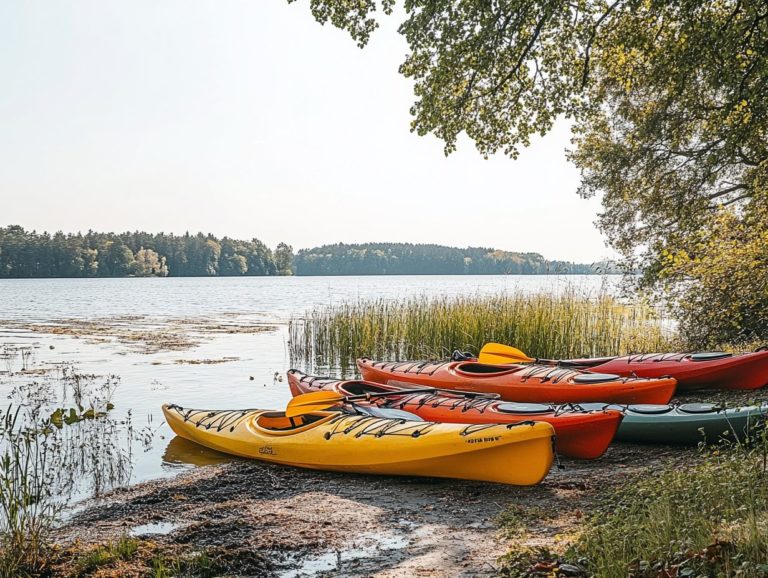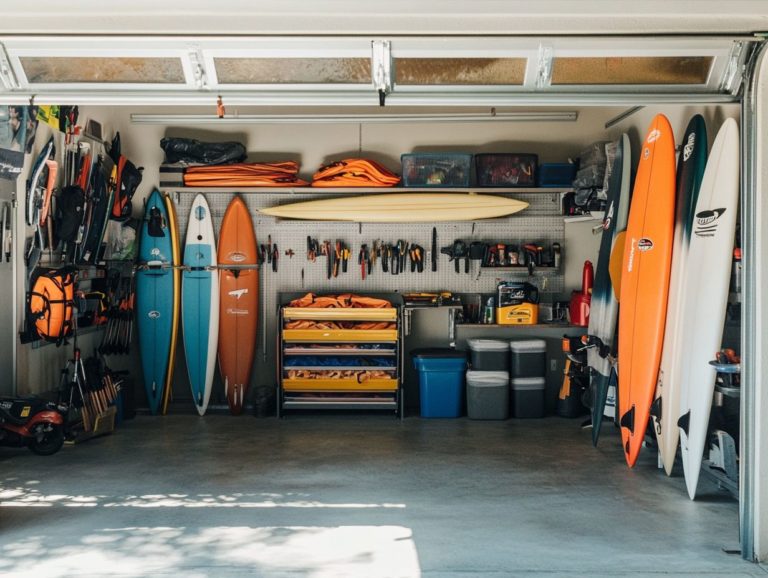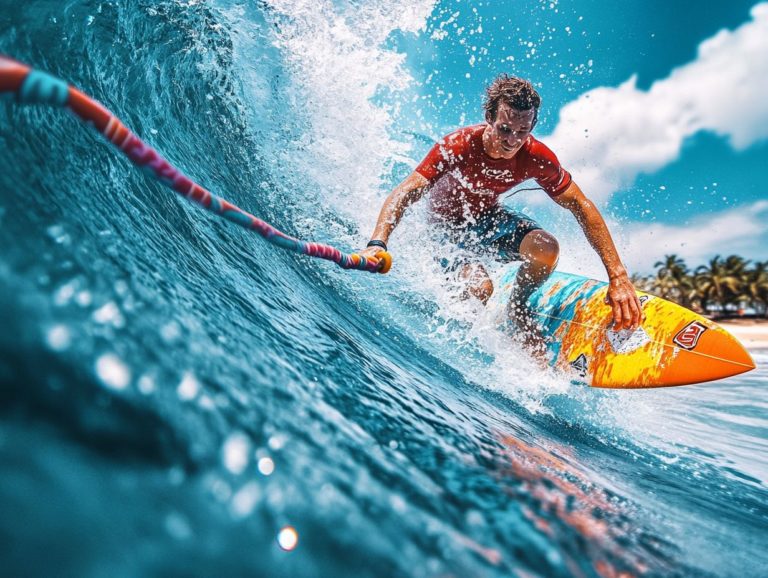Top 10 Tips for Effective Stand-Up Paddleboarding
Stand-up paddleboarding (SUP) isn t just a fun way to explore the water; it s an amazing workout that can improve both your physical and mental well-being.
Whether you re just starting out or looking to improve your skills, understanding the basics can make your experience better.
This article presents ten essential tips, covering everything from choosing the right board to mastering effective paddling techniques. It also covers the benefits of SUP and answers common questions, ensuring you re fully prepared for your next adventure on the water.
Contents
- Key Takeaways:
- 1. Choose the Right Board for Your Skill Level
- 2. Wear Proper Gear and Safety Equipment
- 3. Start in Calm Waters
- 4. Learn the Proper Paddling Technique
- 5. Keep Your Eyes on the Horizon
- 6. Use Your Core for Stability
- 7. Practice Balancing on One Foot
- 8. Be Mindful of Your Surroundings
- 9. Use Your Paddle as a Rudder
- 10. Take Breaks and Stay Hydrated
- How Can Stand-Up Paddleboarding Benefit Your Health?
- What Are the Different Types of Stand-Up Paddleboarding?
- What Are the Common Mistakes to Avoid in Stand-Up Paddleboarding?
- How Can You Improve Your Balance for Stand-Up Paddleboarding?
- What Are Some Advanced Techniques for Stand-Up Paddleboarding?
- What Are the Best Locations for Stand-Up Paddleboarding?
- Frequently Asked Questions
- 1. What is stand-up paddleboarding (SUP)?
- 2. What are the top 10 tips for effective stand-up paddleboarding?
- 3. Do I need any special equipment for stand-up paddleboarding?
- 4. How do I choose the right stand-up paddleboard for me?
- 5. Is stand-up paddleboarding a good form of exercise?
- 6. Are there any safety precautions I should take while stand-up paddleboarding?
Key Takeaways:
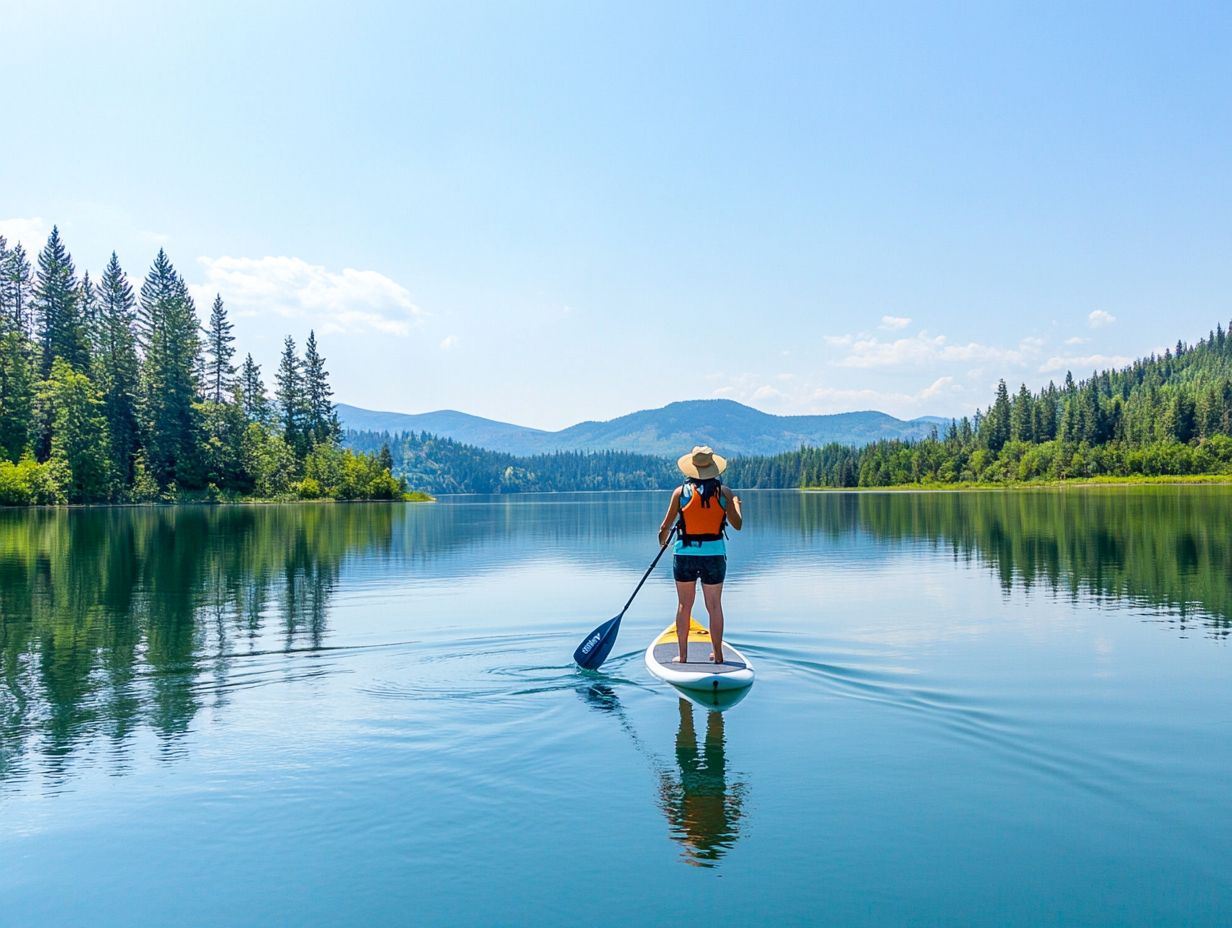
- Choose the right board for your skill level to ensure a comfortable and enjoyable experience.
- Wear proper gear and safety equipment, such as a life jacket, to stay safe on the water.
- Start in calm waters to practice and gain confidence before venturing into more challenging conditions.
1. Choose the Right Board for Your Skill Level
Choosing the right paddle board is essential for a rewarding stand-up paddleboarding experience, especially for beginners. It ensures comfort and stability while you enjoy your time on the water.
The size of your board can greatly impact your performance and confidence. A suitable board makes it easier to learn techniques while taking in the stunning views at locations like Jericho Beach or False Creek, whether you’re in California or the UK.
When selecting a board, consider your weight, experience, and intended usage. These factors will help you decide between a wider, more stable model, or a narrower, faster option.
The Outdoor Master Shark II and Dolphin boards are fantastic choices. They accommodate various skill levels while offering versatility and ease of use. For beginners, starting with a larger, more stable paddle board allows you to focus on balance and paddling techniques without unnecessary stress.
Practicing in calmer waters is also beneficial. This helps you gradually transition to more challenging conditions, ensuring a positive introduction to this exhilarating sport.
2. Wear Proper Gear and Safety Equipment
Wearing the right gear and safety equipment is crucial for every paddle boarder. It not only keeps you compliant with safety regulations but also enhances your overall experience on the water.
Essentials like a life jacket and conducting a thorough equipment check before you launch can significantly minimize risks during your paddleboarding adventures.
It’s vital to develop fundamental safety skills that adapt to the varying conditions you might face. Mastering how to handle rough waters or strong winds can truly transform your experience, allowing you to respond confidently to unexpected challenges.
Regularly practicing self-rescue techniques and familiarizing yourself with local weather patterns is key to ensuring a safer outing. Keeping your gear in peak condition guarantees that your paddle board operates smoothly, adding an extra layer of security so you can fully enjoy the adventure that awaits.
3. Start in Calm Waters
Starting your paddleboarding journey in calm waters is important for beginners. It allows you to develop foundational skills without the added challenge of choppy conditions.
By selecting serene locations, you can focus on balance and paddling technique, making your experience more enjoyable and much less stressful.
Look for calm spots like local lakes, flat rivers, or bays where the water tends to remain smooth. Pay attention to local weather conditions and consider paddleboarding early in the morning or late in the afternoon when winds are typically lighter.
This thoughtful choice not only helps you master the correct paddle strokes but also boosts your confidence on the board. As you practice in peaceful waters, you can devote your energy to perfecting your stance and stroke mechanics, paving the way for more adventurous outings as your skills grow.
4. Learn the Proper Paddling Technique
Mastering proper paddling technique is key to becoming a skilled paddler. It boosts your efficiency and cuts down on fatigue.
Focus on your paddle grip, paddle strokes, and stance. This way, you can explore stunning locations like English Bay and the coastlines of the USA with confidence.
For a comfortable grip, hold the paddle with both hands. Keep your top hand near the T-grip and your bottom hand lower for leverage.
Use long, smooth strokes instead of short, choppy motions. Your body positioning matters keep your feet shoulder-width apart and knees slightly bent for better balance.
To practice these techniques, start in calm waters, focusing on slow, deliberate strokes. As you grow more comfortable, gradually increase your speed. Consistency is key; regular practice will lead to noticeable improvements and a boost in your confidence on the water.
5. Keep Your Eyes on the Horizon
Focus on the horizon to maintain your balance while paddle boarding. A fixed point helps you stay steady and reduces your chances of falling.
This technique stabilizes your center of gravity, allowing you to glide smoothly across the water. You can also try yoga or balance exercises to strengthen your core and improve your stability.
Whether navigating choppy waters or gliding across tranquil lakes, keeping your gaze fixed on the horizon gives you the power to anticipate changes in waves or currents. This leads to better navigation and a safer adventure.
As you adapt to varying conditions, that steady gaze not only boosts your confidence but also fosters a deeper connection with your beautiful surroundings.
6. Use Your Core for Stability
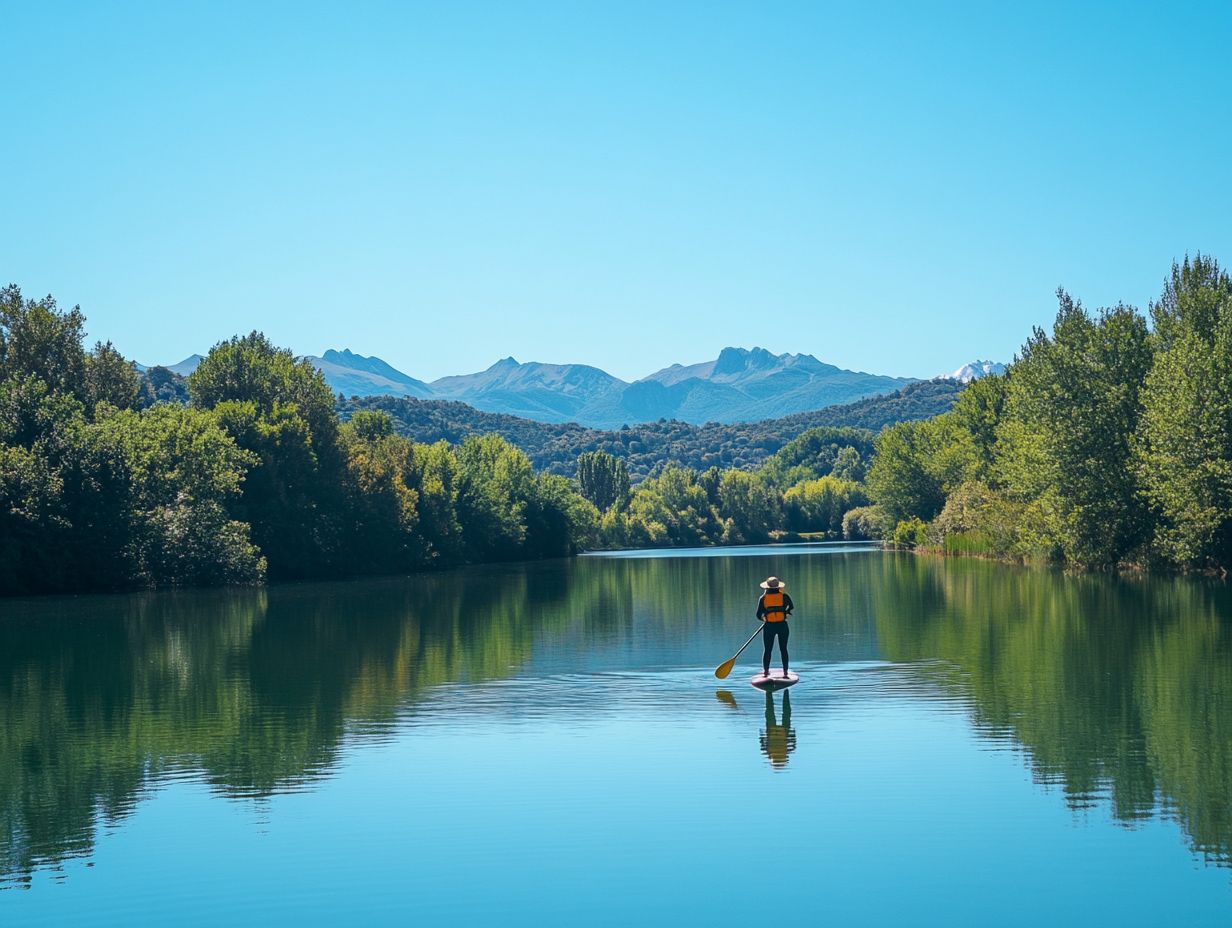
Engaging your core is essential for achieving stability while paddle boarding. It helps you maintain balance and control, enabling you to navigate through various water conditions with ease.
You can build your core with simple exercises like planks, bird-dogs, and Russian twists. Engaging in activities such as yoga and Pilates can improve flexibility and activate those crucial stabilizing muscles.
By regularly practicing these exercises, you ll gain greater control and confidence, ultimately leading to a more enjoyable and effective paddling experience.
7. Practice Balancing on One Foot
Practicing your balance on one foot while paddle boarding is an excellent way to enhance your overall stability and control on the board. This simple exercise sharpens your balance and equips you to handle potential falls.
By regularly incorporating this technique into your routine, you’ll strengthen your core and improve your proprioception, which means your body’s ability to sense its position and movement.
To start, seek out a calm area to practice, then gradually lift one foot off the board while focusing on keeping your body aligned. As your confidence grows, challenge yourself further by extending your arms or even closing your eyes.
Make sure to learn safe falling techniques to avoid injury. When you sense that you might tip over, aim to roll away from the board and enter the water feet-first. This approach reduces the risk of injury and allows for a smooth return to your paddle board, keeping the adventure flowing seamlessly.
8. Be Mindful of Your Surroundings
Being mindful of your surroundings while paddle boarding is crucial for your safety and enjoyment. Understand paddle boarding etiquette, check the weather forecast, and select the right launch location to elevate your overall experience on the water. This fosters a respectful and safe environment for everyone in the SUP community.
Awareness of other paddlers, boats, and wildlife enhances the pleasure of your excursions. Keeping an eye out for fellow enthusiasts prevents collisions and nurtures a sense of camaraderie among those sharing the water.
Being attentive to local wildlife can lead to delightful and unexpected encounters while ensuring these creatures remain unharmed. Checking the weather before heading out allows you to prepare for changing conditions, promoting safety on your adventure.
By adhering to proper etiquette like yielding the right of way you create a smooth experience that everyone can appreciate.
9. Use Your Paddle as a Rudder
Using your paddle as a rudder while paddle boarding significantly enhances your steering capabilities, providing smoother navigation and greater control in diverse water conditions. Master various paddle strokes to turn quickly. This will also enrich your paddling experience.
To steer effectively, use techniques like the J-stroke, which helps guide your board in a curved path, and the sweep stroke, which allows for wide turns. Practicing these strokes in calm waters builds confidence and helps you understand how the paddle responds to your movements.
Incorporating short bursts of power during turns can also pivot the board with agility. Practice in different environments to become adaptable, whether you re gliding across serene lakes or maneuvering through lively currents. These skills will elevate both your performance and enjoyment.
Experimenting with foot placement and body positioning can make a significant difference in your steering success.
10. Take Breaks and Stay Hydrated
Taking regular breaks and staying hydrated is essential for a successful paddleboarding outing. Regular breaks keep your energy up and make your adventure even more thrilling!
Incorporating scheduled breaks into your routine boosts enjoyment and promotes safety on the water. This gives you the chance to recharge and soak in the beautiful scenery around you, which you can record using the Go Paddling app for future reference.
Short, planned pauses allow you to hydrate and assess both your well-being and the conditions around you. A smart strategy is to take a break every 30 to 45 minutes or after completing a specific distance.
During these stops, it s vital to drink water regularly to keep your body s hydration levels in check.
Always wear your personal flotation device; it s crucial for your safety on the water! Having a small first-aid kit on hand ensures you’re prepared for any unexpected situations. Always take a moment to scan the horizon for changes in weather, as staying vigilant is key to enjoying a safe and fulfilling paddleboarding adventure.
How Can Stand-Up Paddleboarding Benefit Your Health?
Stand-up paddleboarding (SUP) presents a wealth of health benefits, delivering an engaging workout that enhances your physical fitness and deepens your connection with nature. The full-body workout involved in paddleboarding contributes to improved cardiovascular health, muscle engagement, and mental well-being, all within the vibrant SUP community.
As you participate in this sport, you’ll likely notice an impressive boost in your endurance and strength. The rhythmic paddling motion engages multiple muscle groups, including your core, arms, and legs, providing a comprehensive workout. This low-impact activity is fantastic for cardiovascular fitness, promoting heart health while enhancing your lung capacity.
The serene experience of gliding over water possesses an unparalleled ability to reduce stress levels, positioning it as an essential component of mental wellness.
Join the vibrant SUP community! Share experiences and make new friends as you paddle while enjoying the breathtaking beauty of the great outdoors.
What Are the Different Types of Stand-Up Paddleboarding?
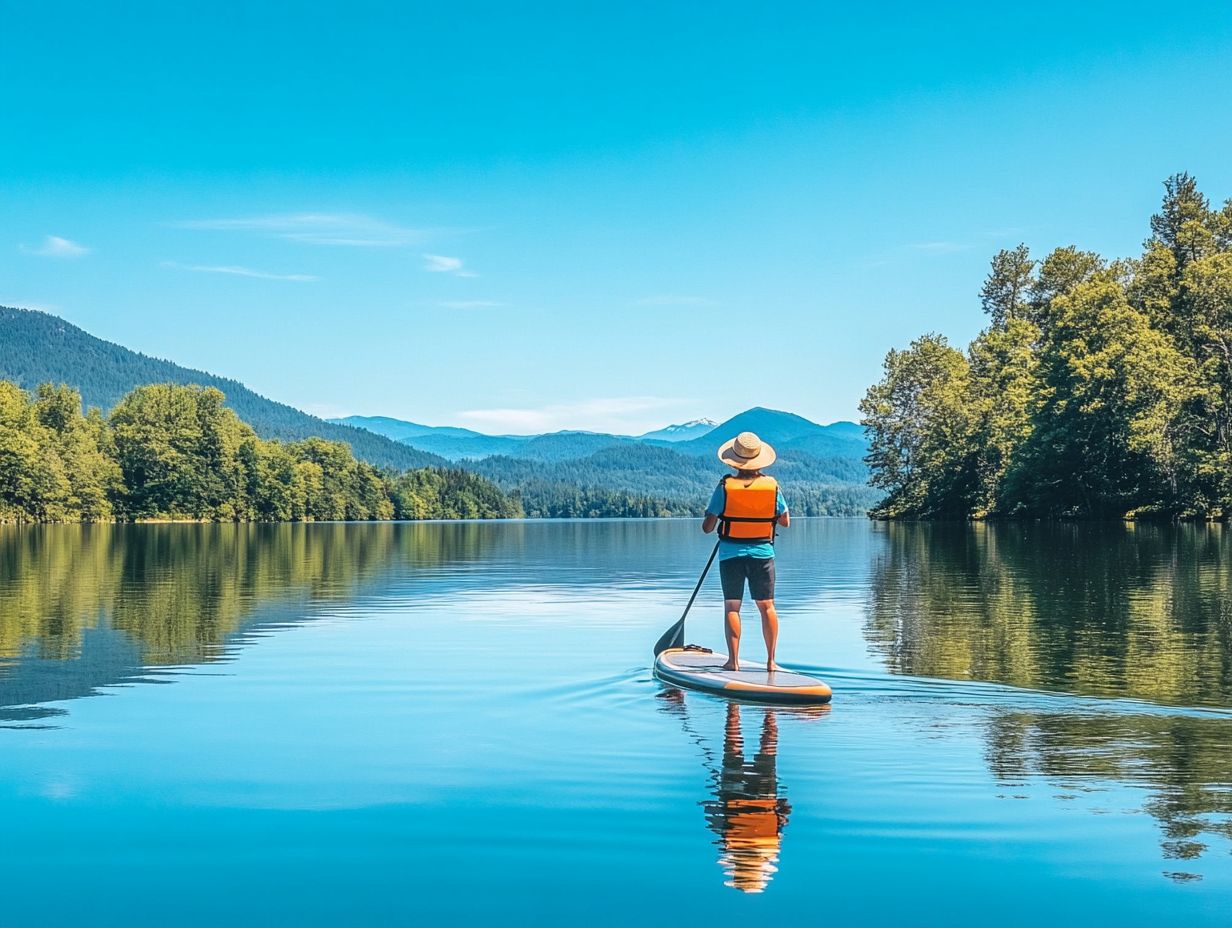
Various types of stand-up paddleboarding await your exploration, each catering to distinct interests and fitness goals. Whether you re drawn to recreational outings, racing adventures, or fitness-focused practices like yoga and Pilates, understanding these options gives you the power to select the approach that aligns perfectly with your personal preferences and aspirations.
If you find joy in leisurely outings, recreational paddling offers a serene experience as you glide over calm waters.
If adrenaline calls your name, racing will entice you with its emphasis on speed and endurance. Fitness enthusiasts like yourself can also delve into specific activities such as SUP yoga, which combines balance and strength training on the water, or Pilates, focusing on core stability and flexibility.
Each style caters to varying skill levels from beginners mastering basic strokes to seasoned athletes fine-tuning their technique and offers unique fitness benefits. There s definitely something for everyone on the water waiting to be explored, inviting you to discover your ideal paddleboarding journey.
What Are the Common Mistakes to Avoid in Stand-Up Paddleboarding?
Common mistakes in stand-up paddleboarding often arise from inexperience, and they can really hold you back, especially if you re just starting out. By being aware of these pitfalls and picking up some essential beginner paddle tips, you can elevate your skills and make the most of your time on the water.
To begin with, many beginners tend to place their feet too close together, which can throw off your stability and make balancing a challenge. It s best to position your feet shoulder-width apart; this simple adjustment gives you much better control.
You might also notice that some paddlers grip the paddle too tightly, which only leads to fatigue and reduced efficiency. Instead, try to maintain a relaxed grip it allows for smoother strokes and improved maneuverability.
Pay attention to your body posture; bending your knees slightly while keeping your back straight can greatly enhance your balance. Start practicing on calm waters to build your confidence and technique, ensuring a more enjoyable experience as you progress.
How Can You Improve Your Balance for Stand-Up Paddleboarding?
Improving your balance for stand-up paddleboarding is crucial for elevating your performance on the water. By incorporating a variety of balance and core-strengthening exercises into your fitness routine, you ll find a significant boost in your stability and control while paddling.
This not only leads to a smoother paddling experience but also minimizes your risk of falling and reduces fatigue during your sessions. Engaging in exercises like single-leg stands, balance boards, and yoga poses such as the tree pose can greatly enhance your proprioception and core engagement. Stability ball workouts are another excellent way to develop the muscles necessary for dynamic movements on the paddleboard.
As a result, honing your balance directly correlates with improved maneuverability, giving you the power to navigate challenging waters with greater confidence and efficiency. This approach will undoubtedly elevate your overall fitness levels.
What Are Some Advanced Techniques for Stand-Up Paddleboarding?
Mastering advanced techniques can unlock your potential and transform your paddleboarding experience. By mastering a variety of paddle strokes and quick-recovery techniques, you enhance your overall experience and performance, even when faced with challenging conditions.
Practicing advanced strokes, such as the J-stroke or the cross-bow stroke, can significantly boost your ability to steer and maintain speed while minimizing fatigue. Focusing on quick-recovery methods like the low brace or the step-back maneuver allows you to regain your balance swiftly whenever stability is compromised.
To practice these techniques effectively, consider using a buoy or a friend as a target. This approach encourages repeated attempts, helping to build muscle memory. By integrating these strategies into your routine, you ll not only gain confidence but also enjoy a more exhilarating and controlled experience on the water.
What Are the Best Locations for Stand-Up Paddleboarding?
Some of the finest locations for stand-up paddleboarding are scattered across the globe. Stunning spots in California, the UK, and the USA offer ideal conditions for paddlers like you. These locales present breathtaking views and nurture a vibrant SUP community where enthusiasts connect and share their adventures.
In California, you ll find gems like Lake Tahoe and the magnificent coastline of Big Sur. Crystal-clear waters and dramatic backdrops create a perfect playground. These places frequently host meet-ups and events, attracting paddlers of all skill levels. There s always a chance to learn from others or show off your skills!
Across the Atlantic, the UK has diverse waterways, from the serene canals of London to the rugged shores of Cornwall. Each spot offers unique paddling experiences and a welcoming community spirit that encourages newcomers to dive right in and join the fun.
In the USA, destinations like Florida’s intercoastal waterways beckon with warm weather and rich wildlife. These locations provide opportunities for eco-friendly adventures, allowing you to forge lasting friendships with fellow SUP enthusiasts.
Frequently Asked Questions
1. What is stand-up paddleboarding (SUP)?

Stand-up paddleboarding, or SUP, is a water sport where participants stand on a long board and use a paddle to move through the water. You can paddle on calm lakes, rivers, or even ocean waves!
2. What are the top 10 tips for effective stand-up paddleboarding?
- Start with the right board size and shape for your skill level.
- Always wear a leash to stay connected to your board.
- Use proper paddling technique, keeping your arms straight and torso rotating.
- Maintain a relaxed stance with your knees slightly bent.
- Look ahead to help with balance and direction.
- Choose calm and flat water for your first few outings.
- Practice getting back on your board in case of falls.
- Use sunscreen and wear a hat to protect against sun exposure.
- Stay hydrated and bring water on longer trips.
- Have fun and enjoy the experience!
3. Do I need any special equipment for stand-up paddleboarding?
In addition to a stand-up paddleboard and paddle, you will also need a leash, life jacket, and suitable clothing for the weather and water conditions. Optional items include a waterproof phone case, sunglasses, and a waterproof watch.
4. How do I choose the right stand-up paddleboard for me?
The right stand-up paddleboard depends on your weight, height, and skill level. It’s best to consult with a professional or try out different boards before making a purchase. A longer and wider board offers more stability for beginners, while experienced paddlers may prefer a shorter, narrower board for faster speeds.
5. Is stand-up paddleboarding a good form of exercise?
Absolutely! Stand-up paddleboarding is a total body workout that improves balance, strength, and cardiovascular health. It targets muscles in the arms, shoulders, back, and core, providing a low-impact form of exercise.
6. Are there any safety precautions I should take while stand-up paddleboarding?
Yes! Always wear a life jacket and use a leash to stay connected to your board. Let someone know where you are going and when you plan to return, especially if paddling alone. Avoid paddling in areas with strong currents or heavy boat traffic, and always stay aware of your surroundings and weather conditions.

